Caves are a natural wonder that everyone should enjoy during their travels. It’s quite exciting to see caves in person either by yourself or through a tour. We hope you enjoyed the first part of the caves around the world in the Americas and Europe.
We’re on the second part of our magnificent caves in Africa, Asia, and Oceania that you need to see for yourself! Thank you to the 57 travel bloggers (also known as cave adventurers!) who provided their favorite and memorable caves during their travels. Happy caving!
Learn more about the caves in the various countries by clicking below:
- Africa: Somaliland and South Africa
- Oceania: Australia and Tasmania, and New Zealand
Caves in Africa
1. Laas Geel – Hargiesa, Somaliland
Contributed by Lisa from TheHotFlashPacker
You can find the cave paintings of Laas Geel east of Hargiesa, the capital of Somaliland. Only “discovered” by a French group in 2002, it’s obvious after a visit that the local nomads have cherished this site for 1000’s of years.
There are a series of dozens of paintings in several shallow caves. The well-preserved cave pictures include men, cows, wild cats, and giraffes. It’s estimated the paintings are 5,000 – 10,000 years old. It’s possible these caves were also used for defense, as a natural window appears in the farthest cave.
A permit to the cave is $25. Tourists must travel with an armed guard when visiting the caves, or any other places east of the capital city. Watch for wildlife like warthogs and hawks as you head from the main highway to the caves.
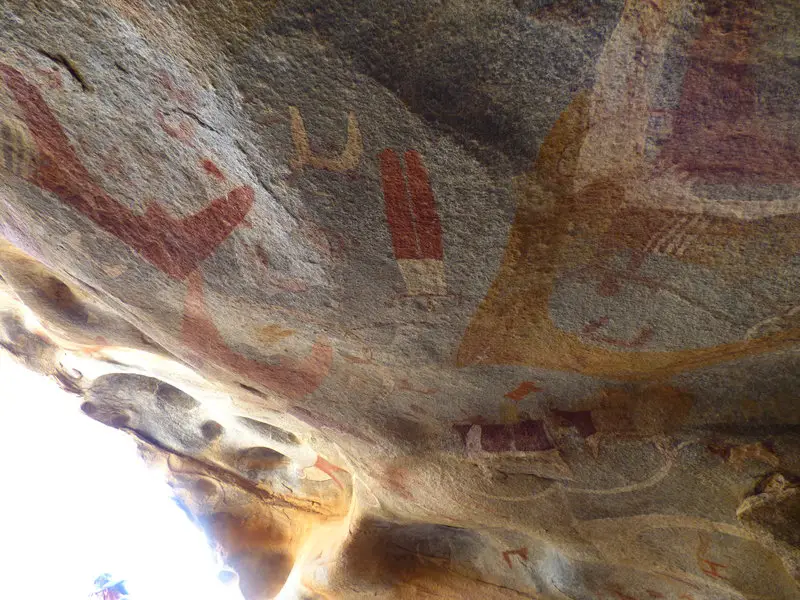
Laas Geel. Photo credit: TheHotFlashPacker
2. Cango Caves – Oudtshoorn, South Africa
Contributed by Erin from Sol Salute
Located in Oudtshoorn in the South African Little Karoo is the Cango Caves. This famous stop along the Garden Route is best known for its ostrich farms and wineries. You should also make time for a tour of the Cango Caves. They offer two options for tours. The accessible tour is great for all ages and abilities and is handicap accessible.
Being young and energetic, we jumped at the Adventure Tour option. It was quite the experience, and not for the claustrophobic. Your guide takes you deep into the caves. You crouch, crawl, and climb through the tiniest of spaces. Sneakers and activewear are ideal for all the shimmying required. There were a few times I got a little anxious because the spaces are tiny and there is no going back once you’ve started. But if you’re not claustrophobic and up for the challenge, this is a great experience!
While on the tour, imagine being the one to discover these caves with nothing but a lantern and rope to get you through. After your tour, visit a nearby winery to reward yourself for your hard work, you earned it.
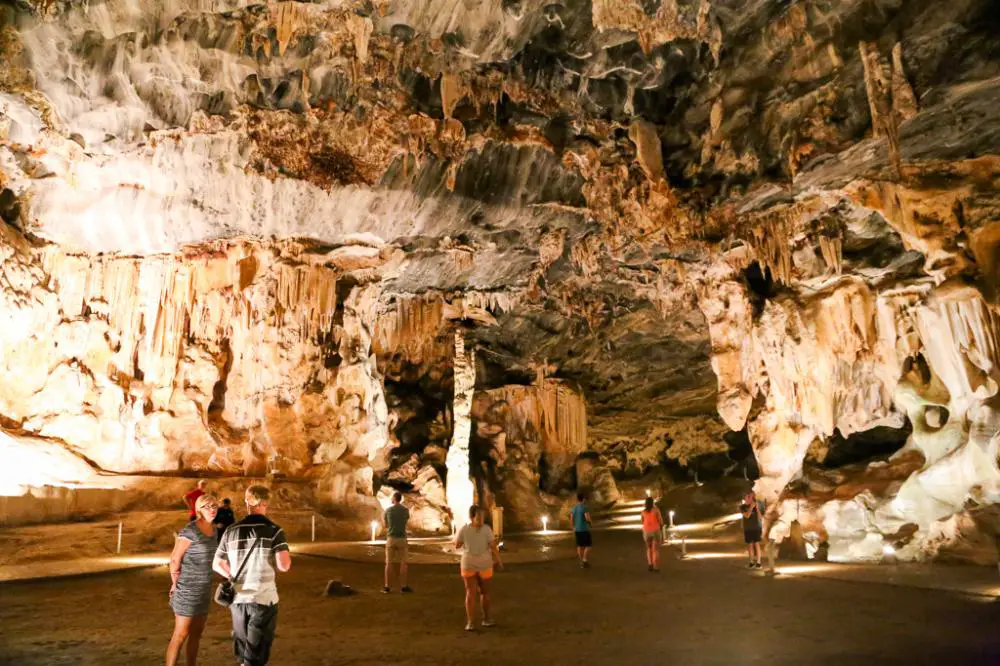
Cango Caves. Photo credit: Sol Salute
Caves in Asia
3. Guilin Flute Cave – Guilin, China
Contributed by Sue from Travel For Life Now
The Guilin Flute Cave, located about 5 kilometers (3 miles) northwest of Guilin, is a must see if you are traveling to Guilin. Many people combine a trip to the cave with a visit to the Longji Rice Terraces. We went to Guilin to take the Li River cruise (an alternative to the more well-known Yangtze River cruise) and then went to the cave.
There are reeds growing outside the cave that were supposedly used for making flutes-the cave’s name comes from those reeds. The cave is 240 meters (260+ yards) long and has a huge cavern that can fit hundreds of people. The stalactites and other rock formations are beautiful. There is a colored light display in the cave-a little cheesy but some people enjoyed that. We went in June when it was less crowded.
To get to the cave, you can take bus 3 to Ludiyan or take bus 213 to Ludiyan Tingchechang. The cave is open from 7:30am – 6pm in the spring/summer and 8am – 5:30pm in the winter. It can get crowded in the high season (summer) and the fall is an excellent time to view the cave. The entrance fee was 130 yuan ($4.60 USD) per person and you may have an additional fee for taking photographs.
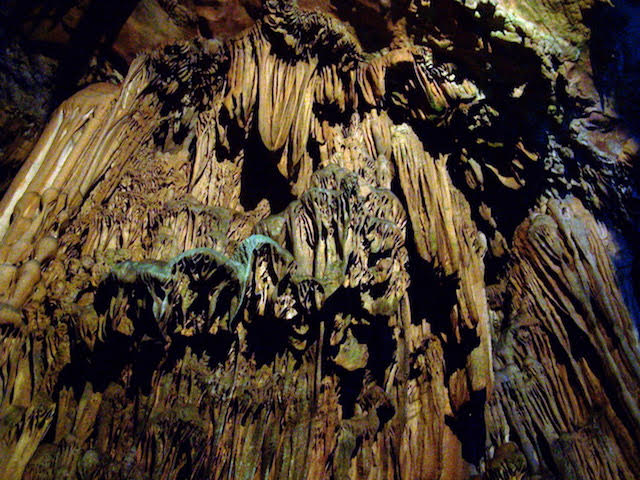
Guilin Flute Cave. Photo credit: Travel For Life Now
4. Water Cave – Yangshuo, China
Contributed by Veronika from Travel Geekery
A few years ago I visited the Water Cave outside of Yangshuo, China, during my time as a student in China. I had Yangshuo as my base and took a bus to the Water Cave. Don’t be like me and don’t go well into the afternoon! I found myself stranded there at 6pm as no more buses were headed back in Yangshuo direction that day.
The Water Cave offers a cool karst cave experience with lots of stalactites and stalagmites. As it’s often the norm in China, many of the chambers are lit by colorful neon lights. You should definitely bring a swimsuit, as one of the highlights in the Water Cave is to soak up in elevated hot spring baths with water of different temperatures, finished off in a muddy one.
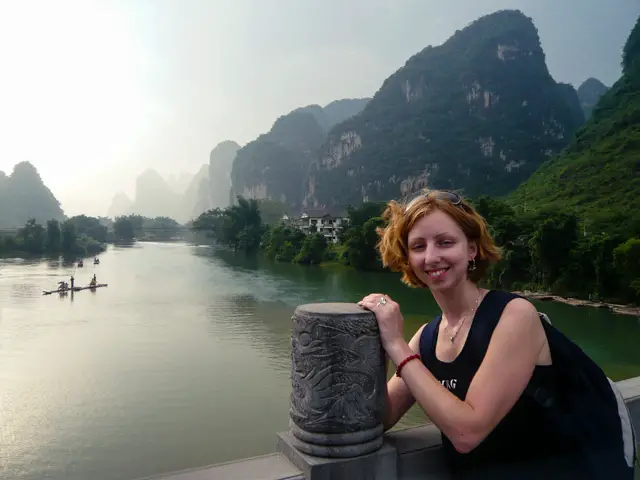
Water Cave. Photo credit: Travel Geekery
5. Naida Caves – Diu, India
Contributed by Oindrila from Oindrila Goes Footloose
Few people know that the island of Diu – a union territory in Western India is home to a man-made cave. Naida Caves are a network of underground hollow spaces in a single rock that were created when the Portuguese indiscriminately excavated the rock for the building of historical structures across Diu. The caves are accessible at any time of the day, but it’s advisable to visit before sunset as you get beautiful views inside only when there is natural light. You can see a lot of hoka trees in the premise and stray patches of grass and wild shrubs along all the entrances. Some of the rooms have roots curtaining the entrance and moss painting the walls. These caves were once used by the Indian Army as shelter when they planned Operation Vijay to oust the Portuguese.

Naida Caves. Photo credit: Oindrila Goes Footloose
6. Elephanta Cave – Elephanta Island, India
Contributed by Rachel from Rachel’s Ruminations
Elephanta Island is home to Elephanta Caves, a UNESCO World Heritage site. Carved around 2000 years ago, the caves were used as Shiva shrines for centuries. While most of these basalt caves were severely damaged, Cave 1 is well-preserved, with rich bas-reliefs of Shiva in various incarnations. The most well-known is a 6 meters (19.7 feet) carving of the three-faced Shiva.
When I visited, I took the boat from the Gateway of India, buying my ticket at the small building next to the entrance. On the boat, it was worth paying the small fee to go upstairs in the open air. Once I arrived on the island, getting to the caves involved a long climb up a hill through a gauntlet of souvenir hawkers. I was happy to see that they have rigged up tarps to cover the stairway, providing a bit of shade as I walked by their displays.
While Cave 1 is the most interesting and ornate, take the time to explore the others. On the one hand, they’re much less crowded. On the other, the carvings are far more degraded, but I enjoyed searching for any remnants.
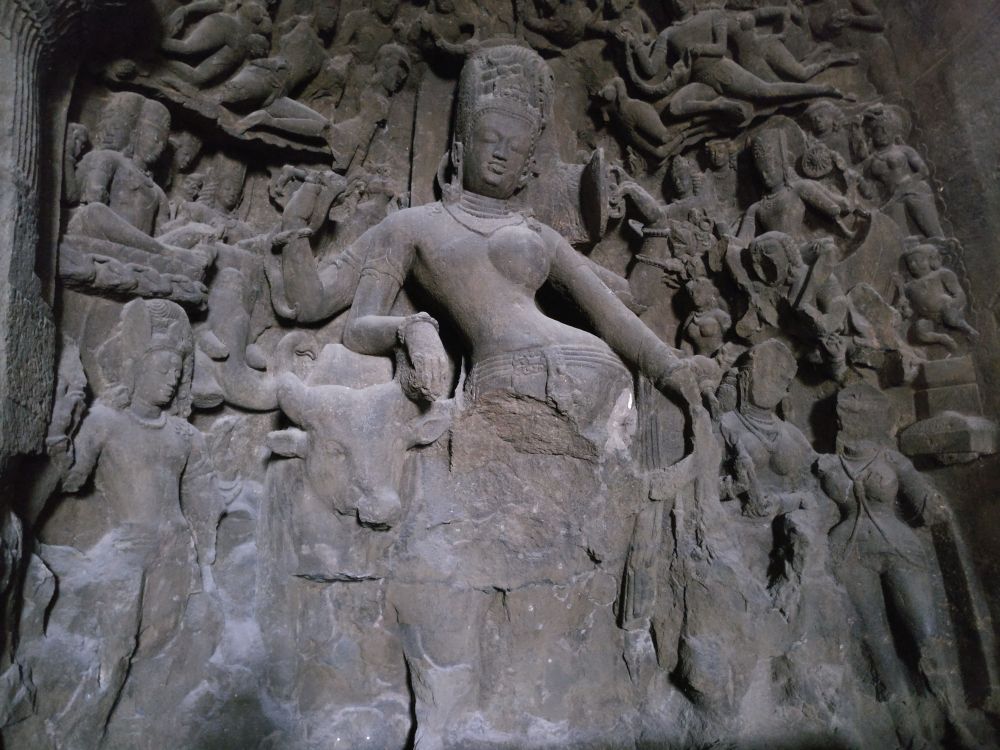
Elephanta Cave. Photo credit: Rachel Ruminations
7. Badami Caves – Karnataka, India
Contributed by Rashmi and Chalukya from Go Beyond Bounds
The Badami Caves are located in the Karnataka state of India. The caves cut out of the sandstone cliffs are exemplary rock-cut architectural style caves. The magnificent rock cave temples consist of 4 cave temples all built in a similar layout with a veranda and a colonnaded hall. Many sculptures and inscriptions decorate the pillars and walls of the halls. Out of the four cave temples, two are dedicated to Lord Vishnu, one to Lord Shiva, and the last one to the Jain Tirthankaras.
Apart from the cave temples, one can also visit the 5th-century Agastya Tirtha Lake and the temples of Mallikarjuna and the Bhuthanatha set on the banks of the lake. There is also an ancient fort of Badami and an archaeological museum next to the lake. These attractions are about 10 minutes drive from the Badami Cave temples. One can have a glimpse of the Agastya Tirtha Lake and its temples from the terrace of the Badami Caves Temples.
The caves are located about 3 hours from the town of Hubli. Hubli has a good frequency of buses and trains from the major city of Bangalore.
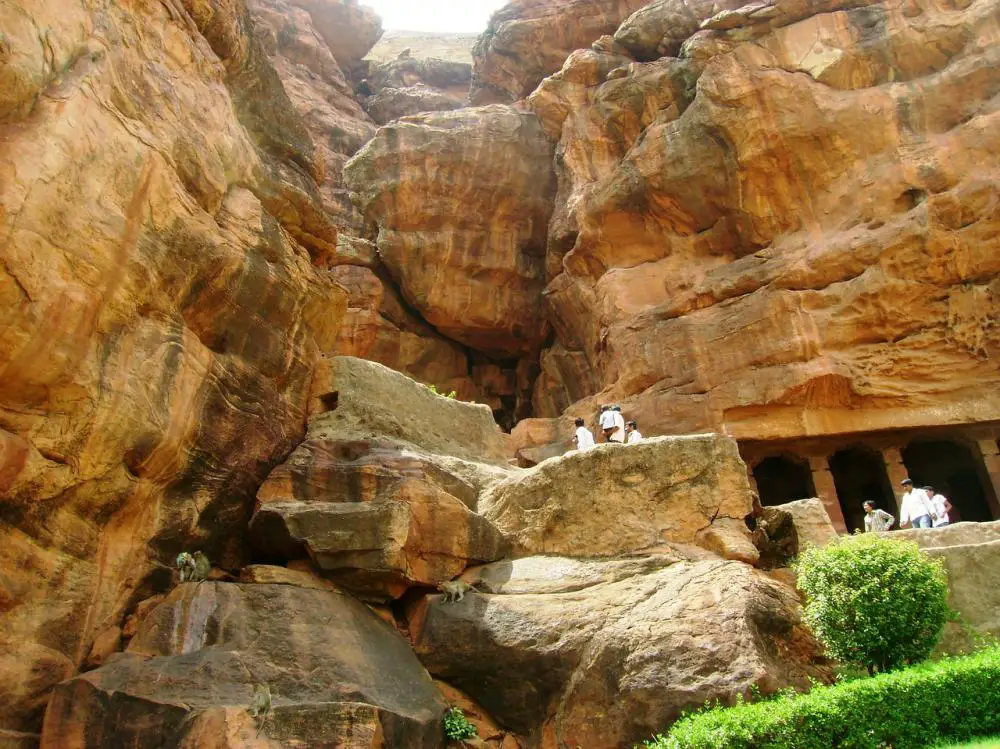
Badami Caves. Photo credit: Go Beyond Bounds
8. Ajanta Caves and Ellora Caves – Maharashtra, India
Contributed by Sarah from ASocialNomad
The Ajanta Caves, near Aurangabad (not far from Mumbai), is a UNESCO World Heritage site since 1983. The caves date from 400 BC and around 30 caves cut into the cliff in a gorge above the river Waghur. They’re famous for the finest surviving examples of Indian painting – Buddhist art and depictions of the Jataka, who are native Indians telling the stories of the previous lives of the Buddha. If you’ve been to Sigiriya in Sri Lanka, then they may look familiar as they’re related to that area. The carving in the caves is beautiful, the paintings faded but still spectacular. There are few people here.
You’ll find a lot more people at the Ellora Caves, some 2 hours away by car. Here are 17 Hindus, 12 Buddhist and 5 Jain caves, also a UNESCO World Heritage Site and all next to each other. They date back to between the 5th and 10th centuries. The carvings are incredible. It’s a testament to the skill of the sculptors and the hardness of the stone that so much is still standing, being that so many are climbing over every available area!
These caves might be off the beaten track for many, but they’re incredible works of art. If you have a day to spare near Mumbai, they’re well worth the trip!
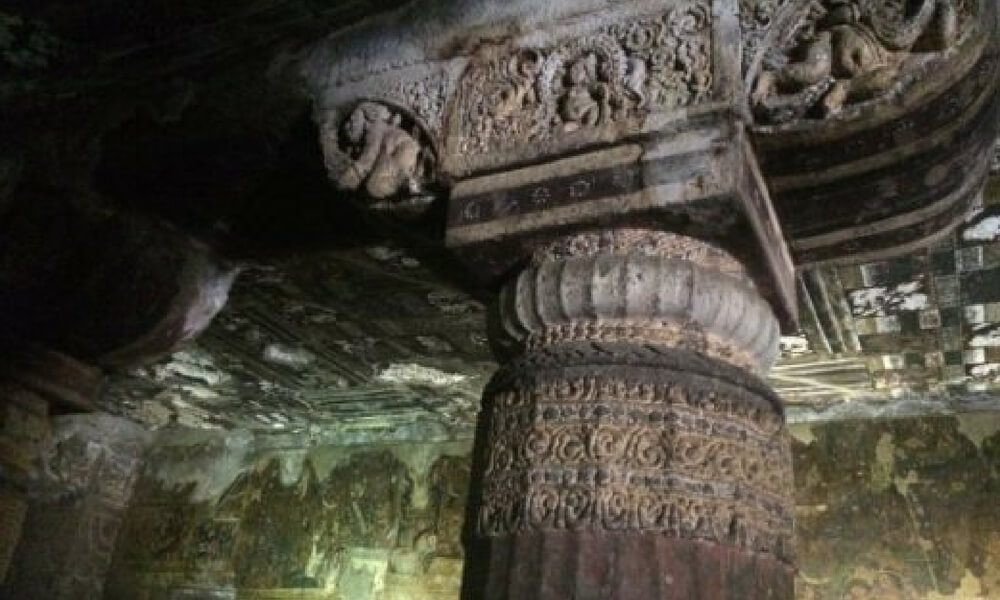
Ajanta Caves. Photo credit: ASocialNomad
9. Goa Gajah – Bali, Indonesia
Contributed by Dana from Adventures With Children
The coolest cave I’ve ever seen is Goa Gajah, aka “Elephant Cave.” The caves exact origins are uncertain but believed to be built as a place for spiritual meditation more a 1000 years ago. The facade has menacing figures carvings to ward off evil spirits. There is both Hindu and Buddhist architectural influences present.
Despite its nickname, it has nothing to do with elephants. The name might be in reference to the stone statue of Ganesh, a Hindu god with the head of an elephant, located inside of the cave.
To get the entrance of the cave you have to walk down a long flight of stairs. The inside of the cave is small, dark, and damp. White trails of smoke fill the air from the burning incense.
Also visitors can enjoy a large fountain in the middle of the courtyard which local tour guides said was holy water. A few brave tourists drank the water as it poured out. Since Goa Gajah is located in central Ubud, it’s an easy stop while exploring all Bali has to offer.

Goa Gajah Cave. Photo credit: Adventures With Children
Read More About Travels in Indonesia
10. Pak Ou Caves – Luang Prabang, Laos
Contributed by Maire from Temples and Treehouses
The Pak Ou Caves are an hour’s meander down the Mekong River from Luang Prabang in northern Laos. The caves are set in a rocky cliff face overlooking the river, and both filled with beautiful Buddha statues.
The lower cave is bigger, lit with natural light, and you can look out at the river below. It’s studded everywhere you look with thousands of Buddhas, placed there over the years by Buddhist pilgrims. From here, the upper cave is a 5-10 minutes climb up a steep stone staircase. It’s smaller and has a more untouched feel, and it’s pitch dark inside. If you don’t bring a torch you won’t be able to see anything! But it’s also far less crowded than the bigger more impressive cave, and I enjoyed its slightly eerie atmosphere.
When I visited the Pak Ou Caves I felt they would become a little too commercialized with boat-loads of tourists crowding into a small area and taking selfies with the statues. They’re definitely still worth a visit. Avoid the tour groups by hiring a boat to take you down the Mekong River which is an amazing experience in itself!

Pak Ou Caves. Photo credit: Temples And Treehouses
Read More About Our Adventures in Laos
11. Niah Caves National Park – Borneo, Malaysia
Contributed by Daniele and Elena from Cycloscope
Niah Caves National Park is one of the highlights of Sarawak, the southern state of Malaysian Borneo. Not only for the jungle, the wildlife and the huge caves, but also for its seamless historical and cultural relevance, since the middle Paleolithic. Human remains found here have been esteemed 40,000 years old and one of the caves features paintings from the iron-age.
In recent years the importance of the cave for the local economy is tied to the collection of birds nest (a delicacy especially appreciated by Chinese people) and guano. Indeed the main cave, whose entrance is among the largest in the world, is home to thousands of bats during the day and swiftlets during the night, making the “turn shift” a real show, happening at sunset.
Take the bus from Miri to Niah National Park. Opening hours are 8am to 5pm. Rooms inside the park are available for 40 MYR ($10 USD). There are 4 beds so each bed comes at 10 ringgit (€2 / $2.50 USD).

Niah Cave National Park. Photo credit: Cycloscope
12. Gua Tempurung – Gopeng, Malaysia
Contributed by Jub from Tiki Touring Kiwi
Located a 20-minute drive from Ipoh is Malaysia’s longest limestone cave, Gua Tempurung. I had zero expectations before arriving at the cave as it’s not a popular tourist attraction for international visitors but is popular with domestic tourists. On arrival the guides kept expectations low, they certainly didn’t talk it up. A couple hours later, after completing the tour number 4 I was stoked. We crawled through narrow passages, slid down rock faces, and walked through the underground river. They’ve recently introduced tour number 5 which I’d love to go back and experience.
How to get there? The nearest tourist city is Ipoh. The best way to get to Gua Tempurung is either private car or with Grab which costs 20-30 ringgit ($5-$7.50 USD). You can take a public bus but the nearest stop is at the turnoff on the road that is 2 kilometers (1.2 miles) from the cave entrance. If you do take public transport or a Grab, ask one of your new caving friends for a ride back to Ipoh.
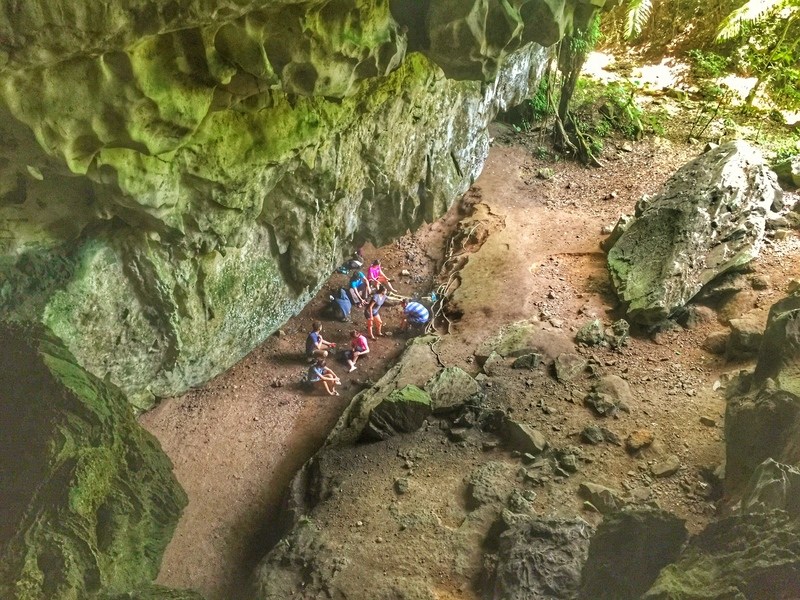
Gua Tempurung Cave. Photo credit: Tiki Touring Kiwi
13. Perak Cave Temple – Ipoh, Malaysia
Contributed by Thomas from TripGourmets
Some of the best attractions around Ipoh are its cave temples as there are over 30 to visit. The one temple I personally liked the most was the Perak Cave Temple north of the old town. You enter the magnificent limestone cave through a beautiful Chinese temple building. One of the first things you see as soon as you’re in the cave is a massive 12 meters (39.4 feet) high golden Buddha statue flanked by four guardian deities.
What makes the cave special though, are all the beautiful paintings on the cave walls. The colorful art shows characters and events from Buddhist scriptures and Chinese mythology. Deeper inside the cave are some stairs, carved into the limestone, which will lead you out of the cave and to the top of the hill. From there you can enjoy a wonderful view over Ipoh and its surroundings. I especially loved the pretty pavilions on top of the hill. Take a seat and a deep breath, which is welcome after climbing some 450 steps to the top.
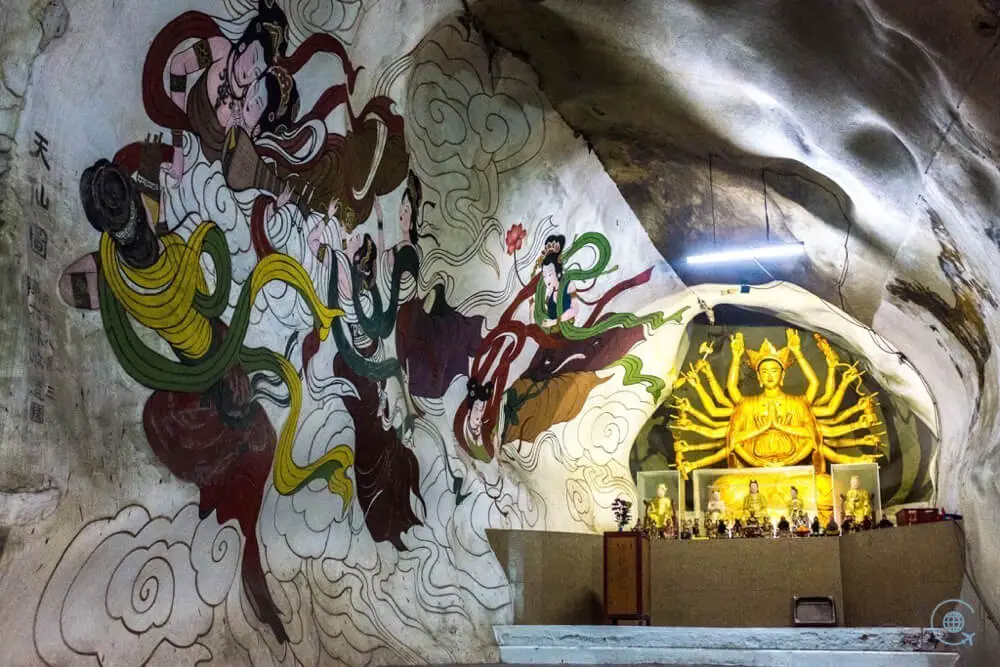
Perak Cave Temple Painting. Photo credit: TripGourmets
14. Batu Caves – Kuala Lumpur, Malaysia
Contributed by Abbie from Speck On The Globe
Come prepared for a bit of a climb as the Batu Caves are 272 steps up into massive limestone hills. The cave is guarded by the Hindu deity, Lord Murugan, the largest of its kind. The Batu Caves contain temples that offer a daily prayer place as well as once a year a place for hundreds of thousands of people who come for a pilgrimage in February. Beat the heat and the crowds by showing up early. You can get to the caves from the Kuala Lumpur train station so it’s a great day trip while in the city. Remember that you’re visiting a temple so keep your shoulders and knees covered.
Entrance into the main cave is free, yet, you can buy a small offering from one of the stands located on the way into the cave. It’s a spiritual experience even if you aren’t religious. The sounds of people praying and the bats flying high above the cave with the streams of light pouring in is a reverent sight. Be cautious of the monkeys! They are fearless. They love food and shiny things, so keep your sunglasses and cameras close.
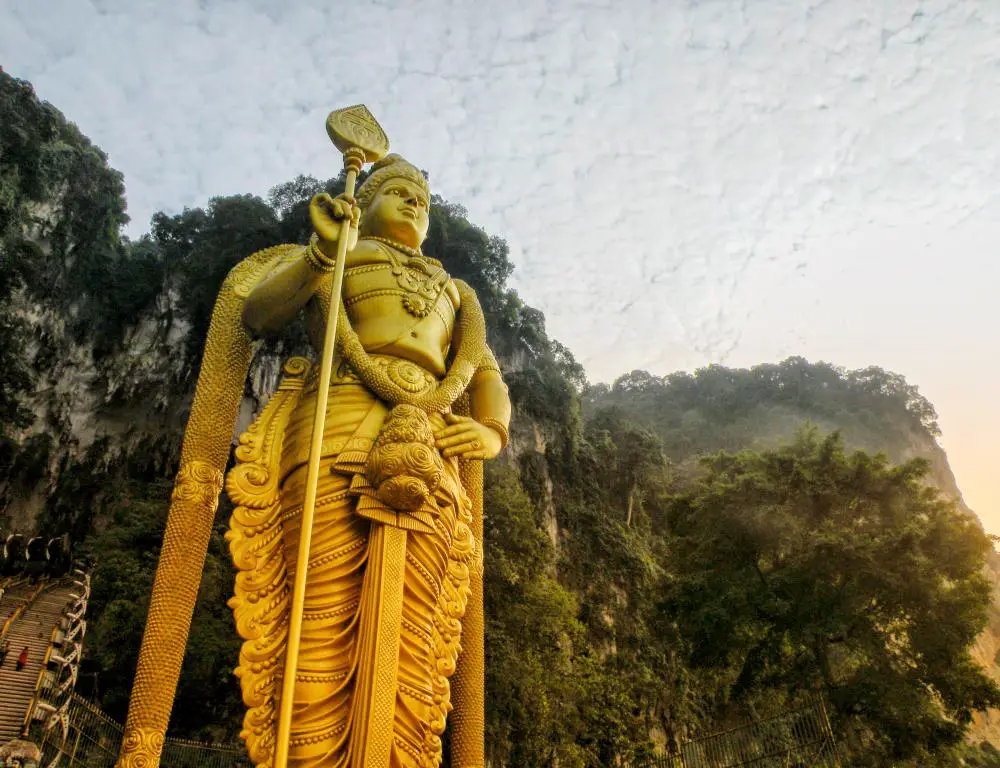
Batu Caves. Photo credit: Speck On The Globe
15. Kawgun Cave – Hpa An, Myanmar
Contributed by Andra from Our World To Wander
Hpa An in Myanmar is a region famous for its limestone caves. You can spend entire days exploring these caves and admiring the Buddhist statues that adorn them. However, one cave that’ll definitely awe you is the Kawgun cave. The cave is famous for its thousands of tiny Buddhas and Buddhist image carvings that decorate the walls and the ceiling. It’s believed that the cave dates back to the 7th century.
You can reach the cave from Hpa An town, either by motorbike, or choose a day trip that covers more caves including this one. Remember that foreigners are required to make a 4,000 MMK ($3 USD) donation.
We visited it with a full-day tour from Hpa An that took us to all the major caves in the region. But Kawgun was definitely one of the favorites due to its intricate walls. You might want to consider visiting it soon as the clay details seem fragile and on the verge of falling. So make sure you include it in your itinerary as soon as possible.
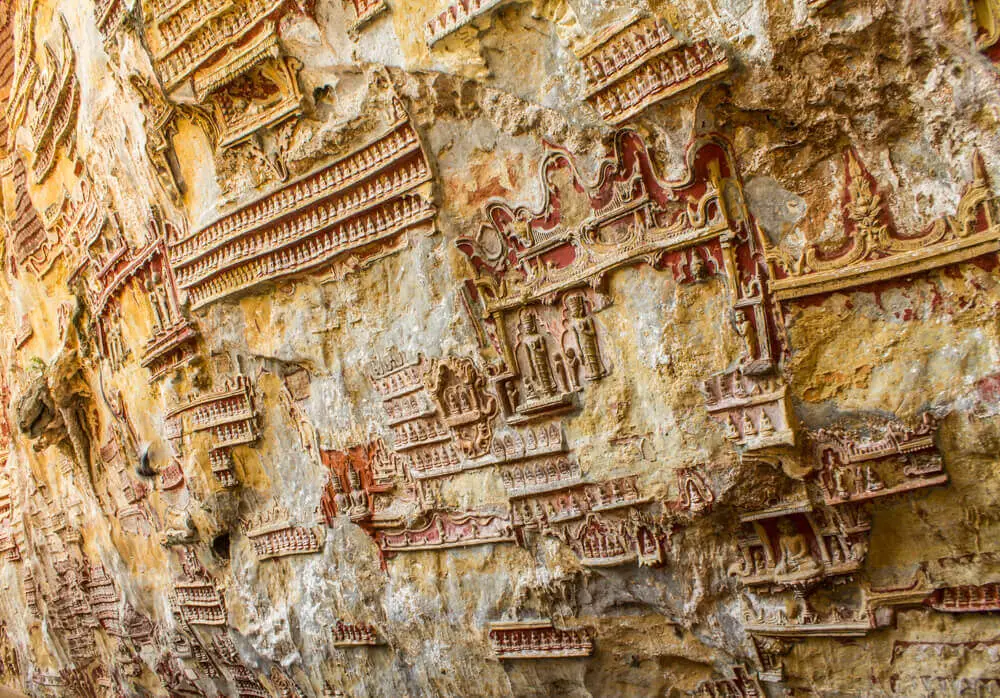
Kawgun Cave. Photo credit: Our World To Wander
16. Saddar Cave – Hpa An, Myanmar
Contributed by Jessica from Longest Bus Rides
Saddar Cave in Hpa An, Myanmar is huge both in length and height. If at all possible, visit during a major holiday. It’s a party scene outside and inside you’ll have the full effect of the cave’s massive size as hundreds or thousands of people crowd in.
First, make your way through the main entrance in the darkness with the occasional electric light hanging overhead to the river. You’ll pass various natural cave features as well as Buddhist stupas.
At the river, board a narrow boat and pass through a small tunnel by waterway back to the entrance. In case you’re visiting during dry season, carry your shoes through the cave, as walking on the dry ground in the heat of the day may be too hot for your toes!
Similar to other caves used for Buddhist religion in Myanmar, you must enter barefoot. It’s free to enter the cave, and the boat ride cost is per boat.
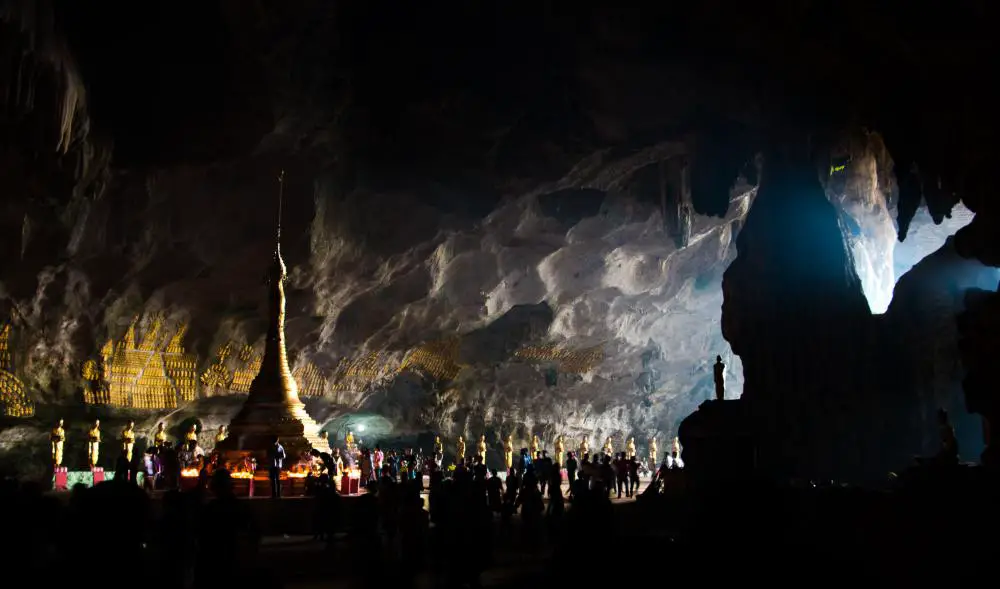
Saddar Cave. Photo credit: Longest Bus Rides
17. Trang An Grottoes – Ninh Binh, Vietnam
Contributed by Mary from Move To Vietnam
When I finished traveling in Vietnam for a good one month, all I can say is that, Vietnam is the land of caves. They have caves everywhere especially up in the north. But my favorite one is the Trang An Grottoes. If you’re planning to go to Ha Long Bay or have been there, it’s composed of over 2,000 pillars.
In Ninh Binh, a UNESCO site, you can explore these pillars by getting on a boat and visit the grottoes. It’s definitely for someone who loves adventures. The boat will go through under the pillars which means you have to dock get down on your chest more than half of the time. It’s a magical experience and definitely a mind blowing scenery.
You can get here from Hanoi and do a day trip or you can also spend a night in the nearby town.
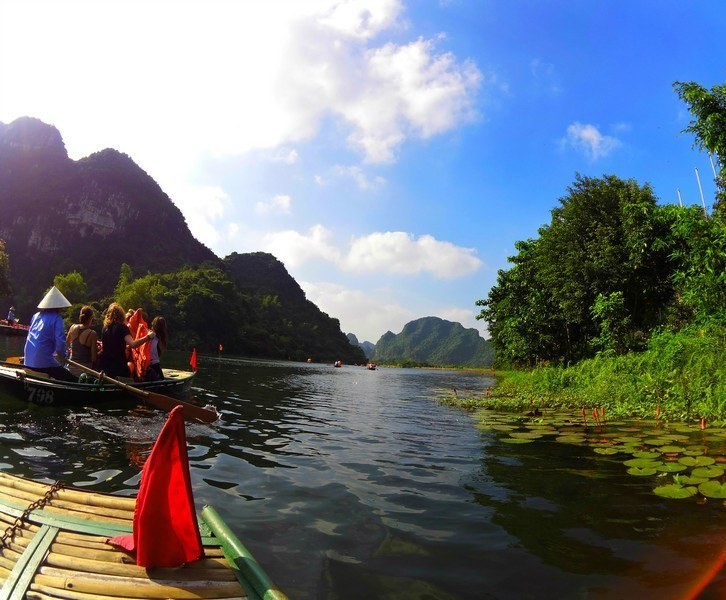
Trang An Grottoes. Photo credit: Move To Vietnam
18. Paradise Cave – Phong Nha-Ke Bang National Park, Vietnam
Contributed by Teresa from Brogan Abroad
Located in Phong Nha-Ke Bang National Park, Thien Duong Cave, also known as Paradise Cave, is the most impressive cave I have ever seen – both in scale and in the beauty of the formations within it. It’s one of the most awe-inspiring natural wonders that you can visit in Vietnam.
It is 31 kilometers (19.3 miles) long and it’s the longest dry cave in Asia. After a buggy ride up to avoid a long climb up the stairs, you’ll continue climbing up a paved ramp to the entrance. As soon as you walk in, you’ll go down a few steps into a chamber with such lofty heights that’ll feel as grand or even grander than a cathedral.
You’ll see some incredible cave formations as you follow the walkway built to protect the cave. A top tip is to avoid big group tours, but this may be hard to do, as it’s a very popular cave. You will have more chances of avoiding them if you visit in the morning.

Paradise Cave. Photo credit: Brogan Abroad
Read More About Vietnam Travels
Caves in Oceania
19. Jewel Cave – Augusta, Australia
Contributed by James from Where You’re Between
Following the line of Margaret River’s stunning coastline is Caves Road, a beautiful drive that starts outside Busselton on the north coast and ends at Augusta almost 70 miles (112.7 km) later. The road is named after the series of caves that line its route. In the north in Yallingup is Ngilgi Cave, named after an Aboriginal spirit.
Drive south along Caves Road – through the thick forest trees and past the rolling vineyards – and you reach a cluster of caves. The furthest south is the largest – Jewel Cave, outside Augusta. Jewel Cave is named after the crystal formations that have slowly moulded around the huge stalagmites and stalactites over thousands of years.
Entry to Jewel Cave is only available via an excellent guided tour that follows a walkway that descends deep underground. The Jewel Cave is formed of three huge open chambers at three different levels. Despite the depth of the cave, long thin roots from the karri trees above the ground reach into the Jewel Cave in search of water. Two of the caves’ most impressive walls of stalactites have been nicknamed the Frozen Waterfall and the Organ Pipes.
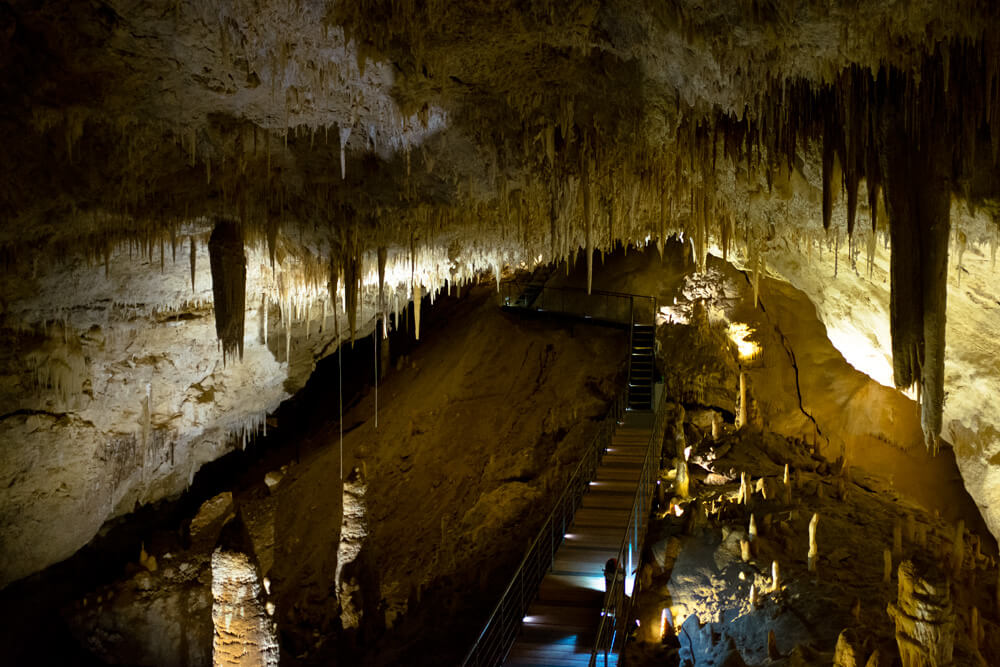
Jewel Caves. Photo credit: Where You’re Between
20. Jenolan Caves – Jenolan, Australia
Contributed by Emma from Emma Jane Explores
Forming one of the eight Greater Blue Mountains regions that were UNESCO World Heritage listed in 2000, the limestone formations that make up the Jenolan Caves are the most ancient discovered open caves in the entire world. They’re accessible with a 2.5 -hour drive from Sydney; although the road towards the caves are narrow and windy.
There are eleven ‘show’ caves which are available for tourists to wander through and marvel at the chambers and formations within at varying degrees of effort. For my money, I love the adventure caving aspect of this region. For my first visit I took part in the beginners caving tour called the plughole. As a bigger girl, I was nervous about squeezing myself through tiny holes. I managed without feeling claustrophobic. As long as you have a decent level of fitness you should be okay to tackle it and it’s a thrill. Even in winter, when the Blue Mountains are bitterly cold, the caves stay toasty, so they’re a good bet for a visit at any time of year. Given that the Blue Mountains area is such a magical part of the world, I recommend a long weekend of the experience. Ensure sure that you visit a few other sites around the area to maximize the most of your stay.
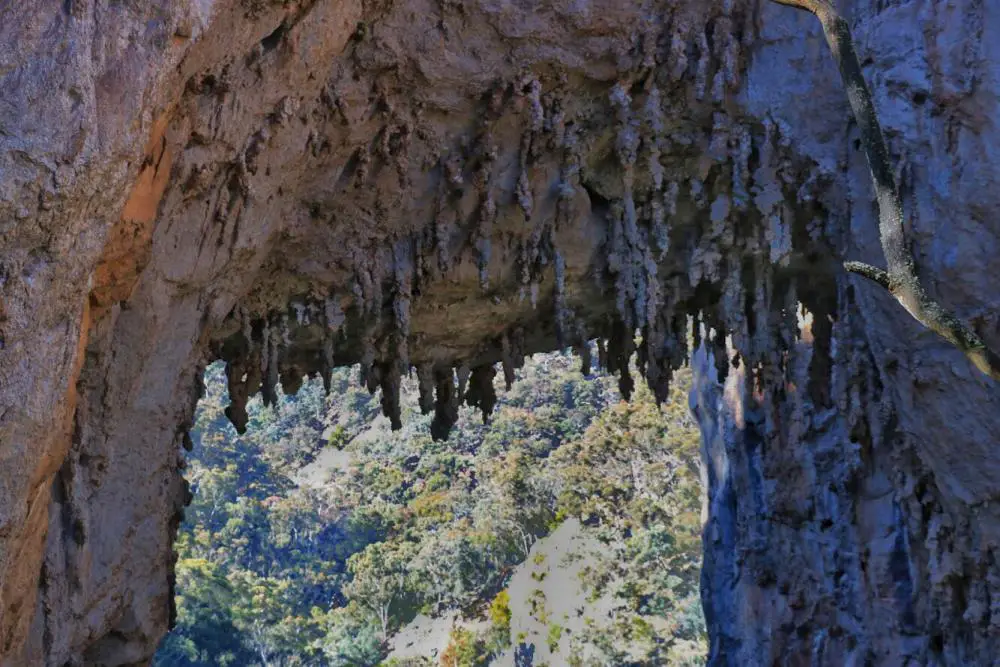
Jenolan Caves. Photo credit: Emma Jane Explores
21. Buchan Caves – Victoria, Australia
Contributed by Michela from Rocky Travel
Australia boasts many beautiful caves that date back to hundreds million of years. The Buchan Caves are the most well-known in South East Australia which are estimated to date back to 400 million years. There are hundreds of smaller caves in the region, but the two open for guided tours are the Fairy Cave and Royal Cave. I visited Buchan Caves in 2015 when I went on a guided tour of the two largest caves, which I’d recommend if you want to see beautiful limestone formations. The highlights in the Royal Cave are the Font of the Gods and the Princess Royal Chambers and in the Fairy Cave you can view the Ivory Palace, the Kings and Blackwood Chambers and more. Truly spectacular stalactites and stalagmites.
Among all caves I have seen in Australia, Buchan Caves have the most scenic underground landscape. Nestled in a picturesque park reserve, Buchan offers the opportunity to exit the caves and go walking in the forest. Moreover it’s a great place to see native birds and animals. I saw the famous lyrebirds, galahs, as well as wallabies and kangaroos. I did the Spring Creek Track up to the falls, a superb walk through some majestic tea trees and rock formations. Located in the East Gippsland of Victoria, about 360 km (223.7 miles) east of Melbourne, visiting the Buchan Caves Reserve makes it ideal for a stopover on the road trip from Melbourne to Sydney along the East Coast.
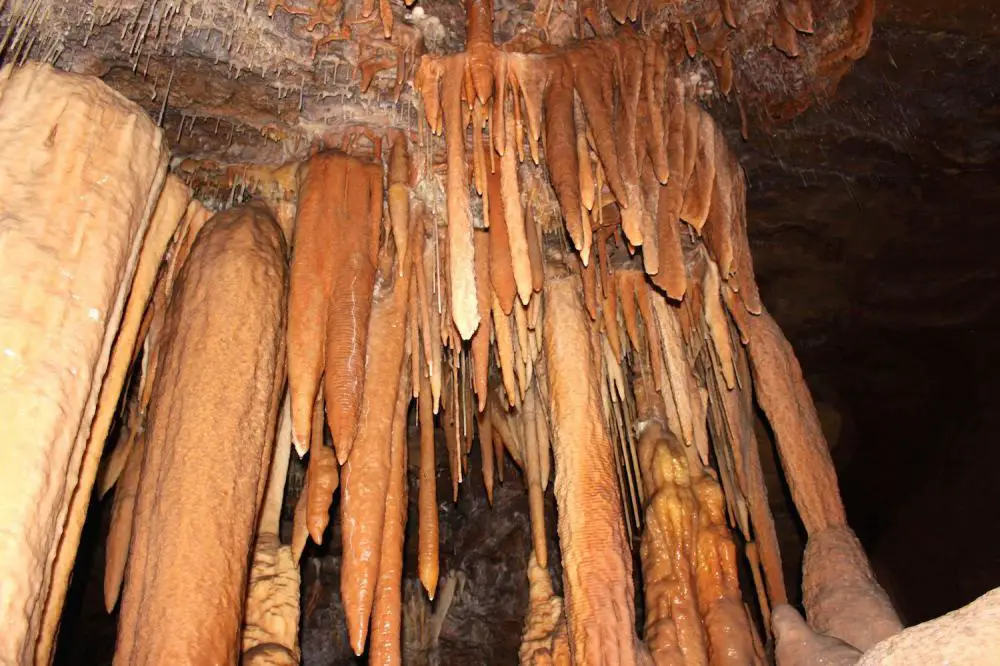
Buchan Cave. Photo credit: Rocky Travel
Read More About Adventures in Australia
22. Hastings Caves – Hastings, Tasmania, Australia
Contributed by Jane from WickedWalkabout
Almost at the bottom of the world, Hastings Caves are located in Southern Tasmania and are one of the main attractions in the area that has dense bushland, waterfalls and massive old growth forest areas.
We visited with our kids and enjoyed the local thermal pools as well as touring the extensive cave system. Formed millions of years ago, local timber cutters discovered the dolomite caves in 1917 by. In total, there are 500 stairs to negotiate to view the many formations.
The Newdegate Cave within the labyrinth of caverns is the largest cave in Australia that is open to the public.Our kids loved the cave tour and it was a highlight of our Tasmanian trip.
The caves are a 90-minute drive south of Hobart.
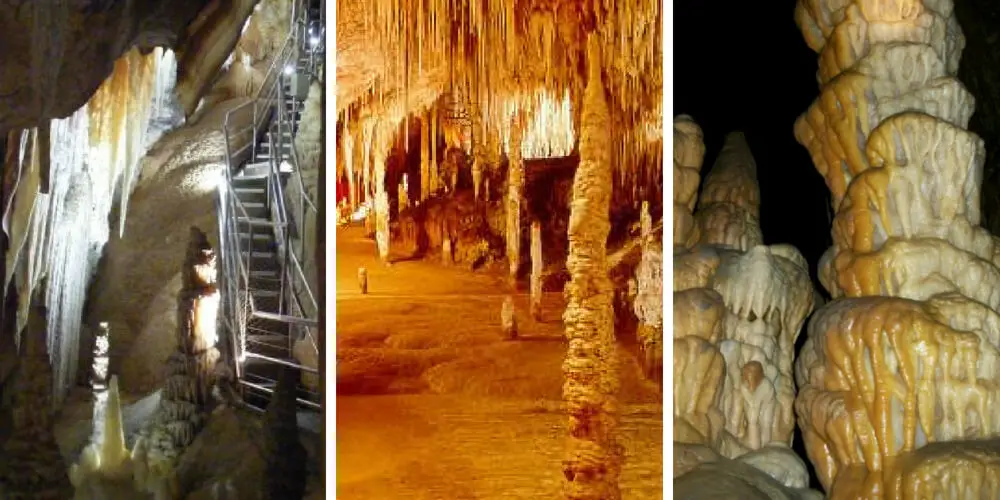
Hastings Caves. Photo credit: WickedWalkabout
23. Mole Creek Cave – Mole Creek, Tasmania, Australia
Contributed by Sally from Our 3 Kids V The World
The Mole Creek Cave consists of 4 different chambers that the guide will escort you through. Brothers discovered the caves in 1906 and they returned to the caves in 1910 and purchased the land with the caves on them. In 1912 they opened the caves to public to view for a small fee. The brothers sold the caves to the Tasmanian Government on 1921.
Mole Creek Cave is located on the way to Cradle Mountain about 90 mins drive from Launceston in Tasmania. Unfortunately you aren’t able to do a self guided tour and will have to book a specific time with a local guide. Group tours have about 20 people and run every hour. The tour guide will explain the creation of stalactites and stalagmites, their colors, and why they are kept within a specific temperature range. These factors assist with preservation of the cave for future generations to enjoy.
Mole Creek Cave has the largest display of glowworms than any cave in Australia. The guide will turn all the lights off and once your eyes adjust, you’ll see the glow coming from the roof of the cave. It’s quite a sight and well worth a visit.
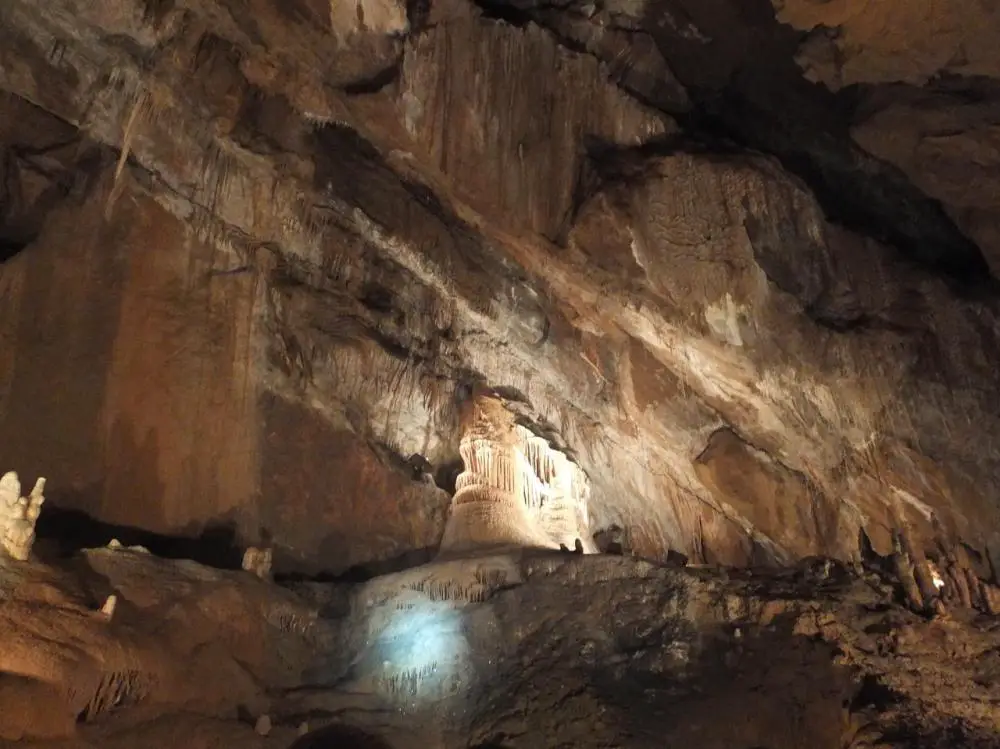
Mole Creek Cave. Photo credit: Our 3 Kids V The World
24. Waitomo Caves – North Island, New Zealand
Contributed by Suzy from Suzy Stories
Waitomo Caves in the north island of New Zealand is often considered an essential place to visit when in this part of the country. The caves are northwest of the island. It’s a 2 hour drive from the popular tourist towns of both Rotorua and Taupo, or 2.5 hours from Auckland making it an ideal day trip!
Caving through these dark tunnels is a magical experience. The rare limestone formations and jagged stalactites, including the tallest stalagmite in New Zealand are fascinating. The main attraction is the unique glowworms that illuminate the ceilings like stars all throughout the interior of the caves.
The best way to see this spectacular natural phenomenon is with the Legendary Black Water Rafting Company who offer tubing tours through the caves. The tour offers the perfect mix of adrenaline pumping activities. You can jump off waterfalls inside the cave and gently float beneath the beautiful glowworm display to soak up the ethereal atmosphere. For the more adventurous types, you can even zipline across the cave and test your climbing and abseiling skills to maximize the experience.
I recommend the Waitomo Caves for an unforgettable day out, and the chance to witness the extraordinary nature that lives beneath the ground. I took the tubing experience and had so much fun exploring the caves, learning about its history, and of course seeing the mystical glowworms for myself!

Waitomo Caves. Photo credit: Suzy Stories
Read More About Our New Zealand Adventures
We’re impressed with the number of caves around the world in Africa, Asia, and Oceania. All of the caves are unique and will be awesome to see on your next traveling adventure. We hope you had a great time exploring the various caves from our magnificent global caves series!
Which caves in Africa, Asia, and Oceania is your favorite? Let us know in the comments!
Pin and save post for later!
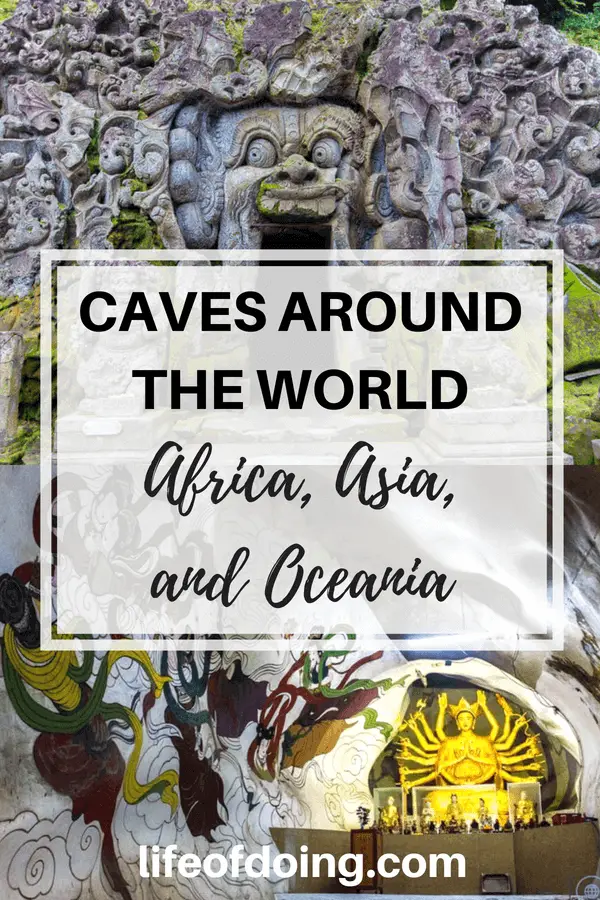 |
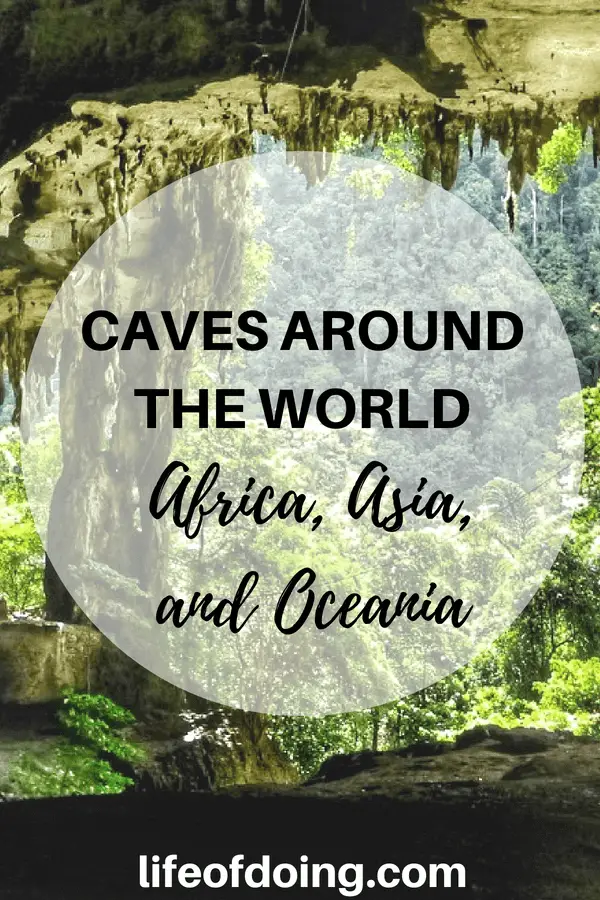 |

1 comment
Nice post. I loved seeing all of these caves.